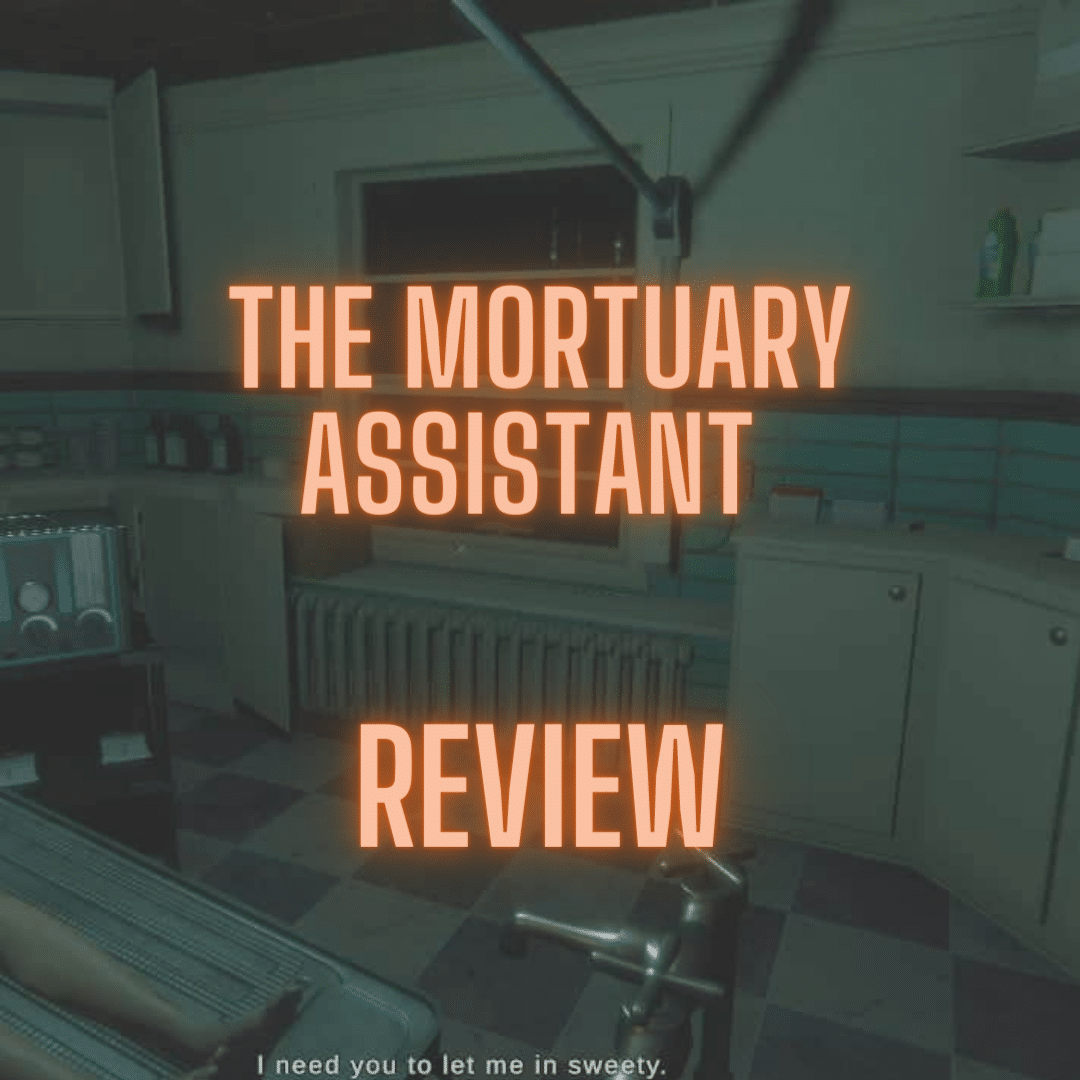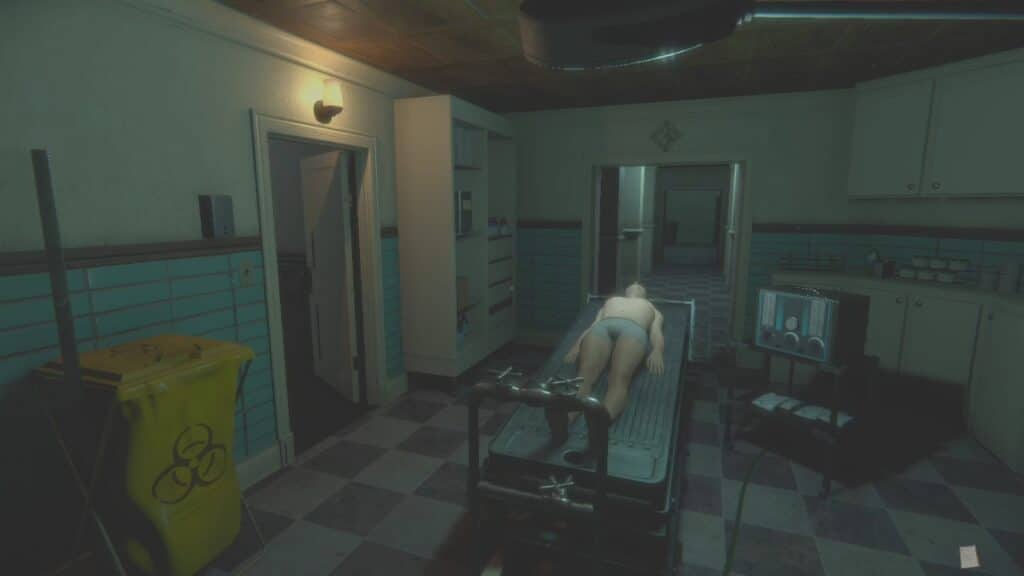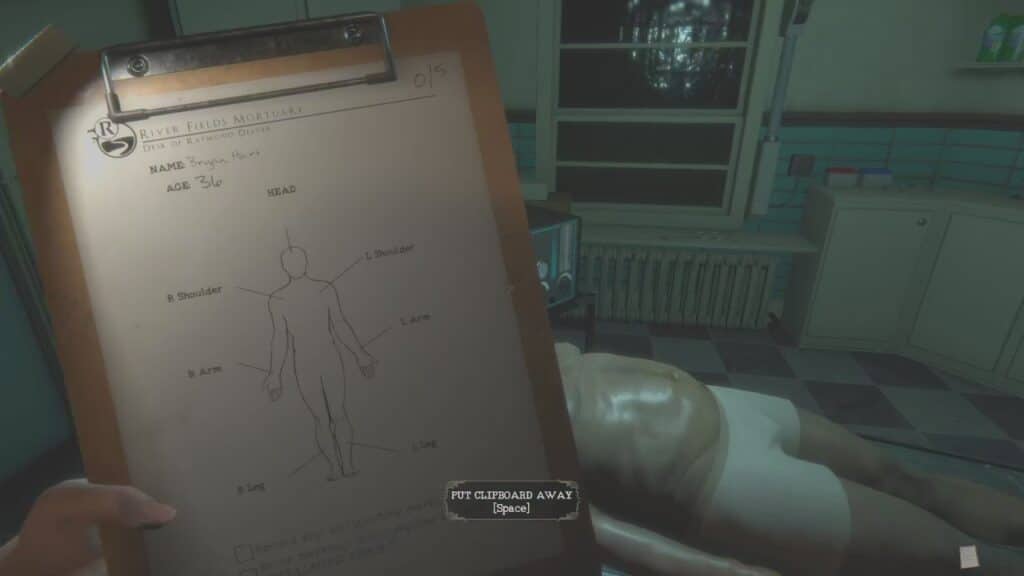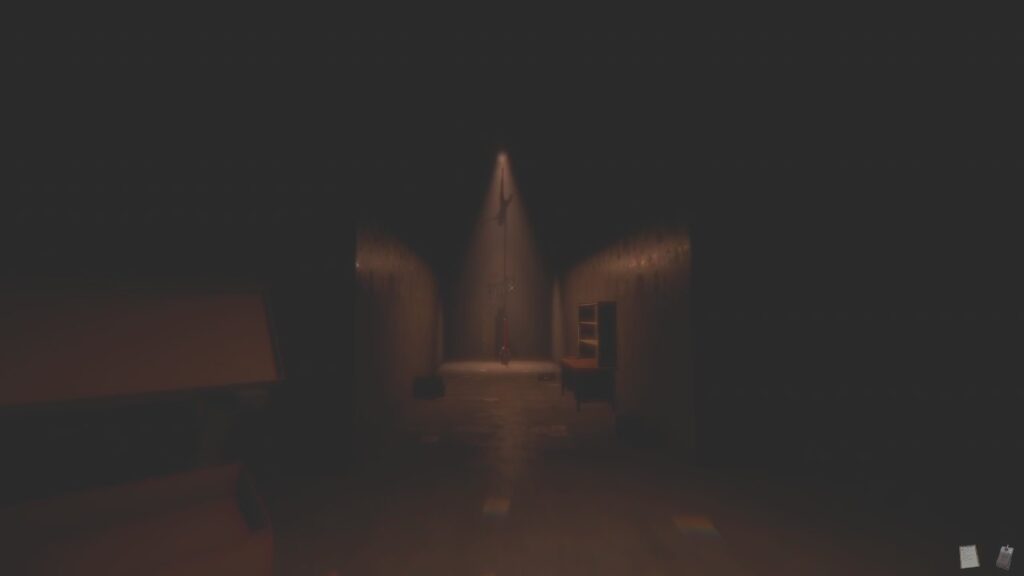Indie horror is in a rough spot these days. With AAA horror basically non-existent and middling AA horror failing to innovate or otherwise flounder in the sub-genres of psychological horror and jumpscare-ridden analog horror, we’re seeing little and less awesome new hopefuls in the horror scene. In walks Mortuary assistant, not with the swagger of a blockbuster striding into the limelight, but with the slow limping creep of an insidious cult hit.
The gameplay is what the title suggests, involving a core loop of preparing bodies through embalming, going down a checklist of draining fluids, sowing jaws closed, and placing eye caps. But things quickly become complicated when only on your 2nd shift do you learn that–oh no! There’s a demon on the loose in the morgue!
Now, this isn’t much of a surprise, and unfortunately, the game reveals its hand a little too quickly. The veil of simply preparing bodies in a spooky morgue where spookier things may-or-may-not be happening is quickly dispelled to thrust you into the main systems of the game.
This especially stings because there’s so much great worldbuilding and tension set up in the first few scenes that it’s a shame they couldn’t stretch it out longer.
It’s about twenty minutes into the game when all hell breaks loose and you’re tasked with expelling a demon from one of three corpses in cold storage. This sets off a series of forty-five-minute-ish shifts that pit you against a demon residing in one of three bodies, and the time it takes for said demon to possess you.
Now this may seem a little grand, but there’s something humble about the gameworld. It doesn’t oversell itself or go too big in it’s setting. From the harsh fluorescent operating lights to the placading soft red color scheme of the waiting room–it doesn’t feel like you’re in a horror game, it feels like a real place that’s slowly becoming hostile. It’s something often forgotten in indie horror and it immediately sets The Mortuary Assistant apart from the current offerings. While it ultimately does fall into some of the indie horror trappings in the late game, for the most part The Mortuary Assistant shows that restraint is the key to scarring your audience.
I was genuinely terrified when I was deep into my embalming checklist and heard the soft knocking on the window looking into the operating room. I lurch away from the operating table to survey my surroundings, and thats when I notice the window overlooking the room was open. No jumpscare, no orchestra blasting to life in my ear, just the soft trickle of rain from outside and the flutter of wavering lights on the ceiling.
Sometimes the spooks aren’t as subtle, but they’re just as effective. The scares present themselves plainly, like a shadow man overlooking the operating table, or a crouching specter at the end of the hall. Hauntings like these happen randomly over the course of the night, with some scripted ones peppered in that progress a personal plot about the main character Rebecca’s troubled past. All the while you’re going down your embalming checklist and paying close attention to the environment to determine the demon’s name and chosen host for the evening.
Things escalate as the night goes on and you begin to feel the pressure of the demon’s hold on you. You check on your sanity via a clever system of scribbling on a sticky note, the more refined the scribble, the worse off you are. Hauntings increase and changes to the mortuary around you become frequent, and various terrifying monsters begin to close in, appearing above cadavers or peering around corners.
These escalations put you in a speedrun mindset as you try to hammer out the embalming list, throwing open cabinets to find the damn scalpel, growing increasingly paranoid of each corner you turn and each patrol you make around the morgue for clues as to the demon’s name in order to banish it. 
It’s brilliant.
You must look around for clues, you cannot be still as this supernatural clock is ticking down, but the way The Mortuary Assistant handles it’s scares is so effective I was constantly petrified but forced to move forward. There is some really, really great stuff on display here.
Maybe you notice that one corpse gives a little twitch, or another develops some less-than-subtle scratches on it’s body. You use disturbances as cues to help you identify the name of the demon and the body it inhabits. You rush back to your desk and log into a database to drill down the clues, popping in cassette tapes left behind to walk you through the process.
This is thrilling for the first couple of nights, but the challenge The Mortuary Assistant faces is that these tasks do not change from night to night.
The exact item placement moves from night to night but the routine doesn’t. So by the time you’re halfway through the game, it becomes a question of how quickly you can knock out your embalming routine to avoid possession, rather than investigating new hauntings or adapting to new situations, new clues to look for, new roadblocks in your work, etc. It becomes pretty static pretty quickly. I would have done wonders for the game to introduce a few surprises as the night went on. Maybe the demon swaps bodies around, or hides some of your supplies, or perhaps there is some sort of medical complication with the embalming procedure so you need to consult your databases and problem solve–anything to break of the monotony of the process.
Despite some shallowness in the mechanics, I can’t overstate how effective the scares are in those first couple of nights. Even in some of the later shifts the game still managed to throw a few surprising scares my way. Whether it be a shadow man clinging to the light on the ceiling, or a man peeking out a cabinet–that a normal person would no way fit in–there is some serious craft on display here. I just wish it could have been stretched out a little longer, with some interesting twists in the gameplay thrown in.
You’ll need to decide if you’re interested enough in Rebecca’s story to see the Mortuary’s Assistant through to the end. The solid voice acting definitely helps, and I want to commend the writing. There’s a grounded quality to it that feels very natural and does a fantastic job of explaining this otherworldly situation without overexplaining it. As with the scares, developer DarkStone Digital knows that keeping the dialogue taught and succinct reinforces the mood of the game.
All of the issues The Mortuary Assistant faces come in the later nights. Rebecca’s past is slowly unraveled through some surreal, nightmarish scripted sequences. Unfortunately, most of these fall into the malaise of “psychological” horror where reality fades away and you’re forced to walk through broken mindscapes of mental hospitals and dank caves where the plot is spoon-fed directly to you. There are some nice segments involving a claustrophobic and filthy apartment that tonally are pretty on-point, but that’s the exception of these sequences.
Even if it’s lost in some of these sequences, the strength of this game remains in its subtlety, its small morgue and thoughtful scares. 
Simply dropping the player in these dreamy sequences feels dull and unearned, even if those transitions are pretty slick. I would have loved for the game to work in these plot beats in a more natural way within the gameplay look and morgue itself.
Ultimately there is a lot to love about The Mortuary Assistant. Its tone is evocative and sinister, it’s scares are earned and crafted. DarkStone Digital understands how to set the scene for the horror to creep in. Even if the core gameplay loop isn’t fleshed out enough to stay for all five shifts, there’s enough skill on display here that it’s worth at least a few shifts from any discerning horror fan.
You can buy The Mortuary Assistant here on steam



